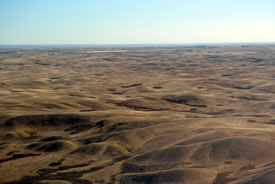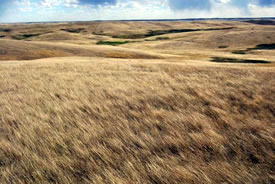Heterogeneity in grassland conservation? These university students say yes!

Buffalo Valley, SK (Photo by NCC)
Should heterogeneity be a new buzzword in grassland conservation? OK, maybe it’s not the easiest word to say or remember but according to ongoing research, the answer is a resounding, "Yes."
During the winter of 2014, students in a landscape ecology class at the College of Agriculture at the University of Saskatchewan were tasked with exploring several questions related to the long-term management of the Nature Conservancy of Canada’s (NCC's) Buffalo Valley Preserve. These questions included:
- Should fire be returned to the landscape as a management tool?
- What is the ideal mosaic of range and riparian health for the property?
- How should grazers such as bison and cattle be best managed and what impacts do they have on the biodiversity of the property?
- What role do the saline wetlands on the property play in the overall biodiversity of the property?
The Buffalo Preserve is an approximately 4,000-acre (1,620-hectare) property owned and managed by NCC. It is part of a much larger remnant patch of native grassland within the Missouri Coteau region of south-central Saskatchewan. This remnant patch is a prime example of natural mixed-grass prairie and is critical habitat for countless plants and animals as well as many species at risk that are native to the area.

Buffalo Valley, SK (Photo by NCC)
In small groups, the students conducted a literature review on their chosen topic and reported their findings back to NCC. The overwhelming response of this literature review was that an overall healthy grassland ecosystem requires periodic disturbances and a diverse mosaic of vegetation communities. In other words, a healthy grassland ecosystem is a heterogenic landscape. Each individual species that lives within the grasslands ecosystem plays its own role and has its own individual habitat requirements. Therefore managing for individual species will often be counter-productive when the ultimate goal is enhancing overall biodiversity. Therefore the recommendation from all of the groups was that to promote biodiversity in the Buffalo Valley Preserve, it must be managed to promote heterogeneity across the landscape.
Non-permanent disturbances such as fire and grazing are important tools for creating this diverse mosaic. The key challenge for land managers will be using these tools effectively to try to mimic natural disturbance patterns. Ultimately this will require a lot more research and the lessons that NCC learns in managing the Buffalo Valley Preserve will provide an excellent example for enhancing biodiversity in other areas of the mixed-grass prairie.
Staff at NCC would like to thanks Dr. Romo and all of the students of the winter 2014 Landscape Ecology and Vegetation Management (PLSC 423) class. While it is still too early to say if any of the group recommendations will be directly adopted at the Buffalo Valley Preserve, the information contained in their excellent literature reviews will certainly be used to inform the future management of the Buffalo Valley Preserve.

